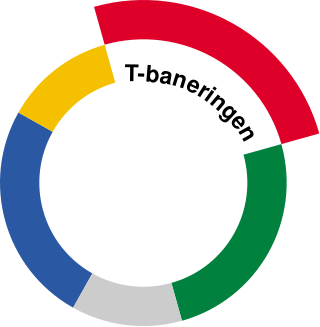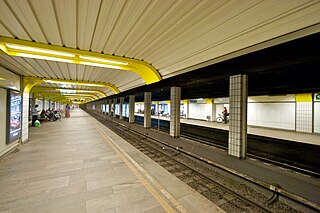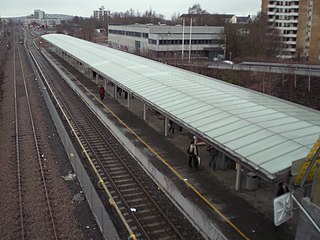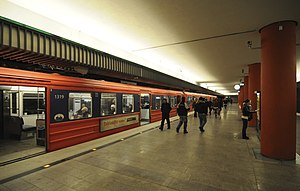
Mortensrud is a rapid transit station on the Østensjø Line of the Oslo Metro. It is located in Mortensrud in the Søndre Nordstrand borough of Oslo, Norway. Construction of the station started in 1995, which was taken into use on 24 November 1997, when it became the terminal station of the line—following a 2.4 kilometres (1.5 mi) extension from Skullerud. The extension cost 215 million kr to build, and most of the section is in tunnels. The station is built in concrete, wood and stone, and cost NOK 35 million. It is served by line 3, in addition to being an important bus terminal for the borough, including a feeder service to Bjørndal. Travel time along the 13.6-kilometre (8.5 mi) section to the city center is 24 minutes. In 2001–02, the station had 2,077 daily boarding passengers. The station serves the surrounding residential area, as well as an adjacent shopping center. South of the station is a turning line for trains.

The Sognsvann Line is a rapid transit line on the Oslo Metro of Norway. It branches from the Common Tunnel at Majorstuen and runs 6.0 kilometers (3.7 mi) to Sognsvann. After Ullevål stadion, the Ring Line branches off. The Sognsvann Line serves the northwestern and northern neighborhoods of Oslo, mostly within the borough of Nordre Aker. The line is owned and maintained by Kollektivtransportproduksjon and has nine stations. The western end of line 5 serves the entire line. Line 4 and the eastern end of line 5 serve the southern part of the line up to Ullevål stadion before branching off and continuing along the Ring Line. This gives an average five-minute headway on the southern part and an average fifteen-minute headway on the northern part of the line.

The Østensjø Line is a 9.0-kilometre (5.6 mi) line on the Oslo Metro which runs from Brynseng to Mortensrud. It further shares track with the Lambertseter Line along the 2.5-kilometre (1.6 mi) section from Tøyen to Brynseng. The line runs through the primary residential areas of Bøler, Østensjø and Søndre Nordstrand. The line is served by Line 3 of the metro.

The Lambertseter Line is a 5.9-kilometer (3.7 mi) line on the Oslo Metro which runs from Brynseng to Bergkrystallen. It further shares track with the Østensjø Line along the 2.5-kilometer (1.6 mi) section from Tøyen to Brynseng. The line runs through a primary residential area of Nordstrand, serving neighborhoods such as Manglerud, Ryen and Lambertseter. The line is served by Line 4 of the metro, which runs every fifteen minutes. This is supplemented by Line 1 that is extended to Bergkrystallen between 6:30 and 19 on weekdays, giving a combined frequency of eight trains per hour.

The Ring Line is the newest rapid transit loop line of the Oslo Metro of Oslo, Norway. It connects to the Sognsvann Line in the west and the Grorud Line in the east; along with these two lines and the Common Tunnel, the Ring Line creates a loop serving both the city centre and Nordre Aker borough. The 5.0 kilometres (3.1 mi)-long line has three stations: Nydalen, Storo and Sinsen. Four-fifths of the line runs within two tunnels, with the 1.0-kilometer (0.62 mi) section between Storo and Sinsen, including both stations, being the only at-grade part. The line connects to the Grorud Line north of Carl Berners plass and with the Sognsvann Line north of Ullevål stadion.

Grønland is a rapid transit station on the Oslo Metro in the Common Tunnel serving all six lines. It is located in the business and residential area Grønland, between the stations Jernbanetorget to the west and Tøyen to the east. The station was opened on 22 May 1966 with the opening of the subway, and underwent refurbishments 1988–92. Peer Qvam was the original architect.

Forskningsparken is a rapid transit station on the Sognsvann Line of the Oslo Metro. It also serves as a light rail station for the Ullevål Hageby Line of the Oslo Tramway. It is located at the north of the Blindern campus of the University of Oslo in the Nordre Aker borough of Oslo, Norway. The decision to build the station was made in 1998, and it opened in 1999, replacing the former station Vestgrensa, and allowed interchange between the metro and the tramway. The Ullevål Hageby Line was at the same time extended to serve the new Rikshospitalet. Forskningsparken is served by lines 4 and 5 of the metro, each operating every 15 minutes and providing services along both the Sognsvann Line and the Ring Line. Lines 17 and 18 of the tramway serve Forskningsparken, operating to Rikshospitalet and the city center.

Carl Berners plass is an underground rapid transit station located on the Grorud Line of the Oslo Metro, and a tram stop on the Sinsen Line of the Oslo Tramway. The square also has a bus stop for lines 20, 21, 31 and 33. Located at Helsfyr in Oslo, Norway, the area has a mixture of apartment buildings and small businesses. The station is the first metro station on the Grorud Line after it branches off from the shared Common Tunnel. North of the station, the Ring Line branches off from the Grorud Line. The station is served by line 5 of the metro and Line 17 of the tramway, with four hourly departures during regular hours. The tram operates every 10 minutes during regular hours.

Storo is a rapid transit station on the Ring Line of the Oslo Metro, and a tram station on the Grünerløkka–Torshov Line of the Oslo Tramway. It is located at Storo in the Nordre Aker borough of Oslo, Norway. The tram station opened on 28 November 1902, and the rapid transit station on 20 August 2003. Metro lines 4 and 5 run to the station. The tram station serves lines 11, 12 and 18. The station is within walking distance of Grefsen Station on the Gjøvik Line. The station also functions as a bus hub, being located along Ring 3. Storo is a mixed commercial and residential area, and a shopping center is located just north of the subway station.

Sinsen is a rapid transit station on the Ring Line of the Oslo Metro. It is located at Sinsen in the Sagene borough of Oslo, Norway. Next to the station is the tram station Sinsenkrysset, that has been part of the Sinsen Line of the Oslo Tramway since 1939. The station opened on 20 August 2006, as part of the first section of the Ring Line. The station is served by line 4 and 5 of the metro, as well as several local bus services. Sinsen is a mixed residential and commercial area.

Vy Gjøvikbanen AS is a Norwegian railway company that operates the passenger train service on the Gjøvik Line. A subsidiary of the state-owned Vy, it operates a fleet of nine Class 69g three-car electric multiple units. NSB Gjøvikbanen provides two different services: the Skøyen – Oslo S – Jaren service is part of the Oslo Commuter Rail; while Oslo S – Gjøvik is a regional service, with only limited stops on the route until Grua. Departures are each 40 minutes, with every third train running to Gjøvik.

Berg is a station on the Sognsvann Line of the Oslo Metro in Norway. Located between Ullevål stadion and Tåsen stations, it is the first station after the Ring Line leaves the Sognsvann Line. The station is located 6.1 kilometres (3.8 mi) from Stortinget station. Berg is amongst the original stations on the line, and was opened on 10 October 1934. It was upgraded and rebuilt in the 1990s, when the Sognsvann Line was upgraded from light rail to rapid transit standard. Three accidents have taken place at Berg station, the latest in 2008. The area around the station is mainly residential. Berg Upper Secondary School is located approximately 100 metres (330 ft) from the station.

Tåsen is a station on the Sognsvann Line of the Oslo Metro in Oslo, Norway. The station is located between Berg and Østhorn stations and is 6.8 kilometres (4.2 mi) from Stortinget. As one of the original stations on the line, Tåsen was opened on 10 October 1934. The station was moved 150 metres (490 ft) north in the 1990s, when the line was upgraded from light rail to rapid transit standard. In 1992, a fatal accident occurred when a T1300 train collided with a snow plowing car ahead of the station.

Grefsen station is a railway station at Storo in Oslo, Norway on the Gjøvik Line. From the station there is also a short railway, the Alnabru–Grefsen Line, to Alna on the Hoved Line. The station is located 6.82 km from Oslo Central Station and is located between Tøyen and Nydalen at 109.2 metes above sea level. It was opened on 20 December 1900, two years before the railway to Gjøvik was finished.

The Alna Line is a 4.3-kilometer (2.7 mi) railway line between Alnabru and Grefsen in Oslo, Norway. The single track line allows direct access between the Trunk Line and the Gjøvik Line, without having to pass via Oslo Central Station. The line is electrified and is owned by the Norwegian National Rail Administration. It is exclusively used by freight trains, and allows trains on the Bergen Line to reach Alnabru Freight Terminal.

Oslo Commuter Rail is a commuter rail centered in Oslo, Norway, connecting the capital to six counties in Eastern Norway. The system is operated by Vy and its subsidiary Vy Gjøvikbanen, using Class 69 and Class 72 electric multiple units (EMU). The network spans eight routes and 128 stations, with Oslo Central Station (Oslo S) as the central hub. The trains run on 553 kilometers (344 mi) of electrified mainline railway owned by the Bane NOR. Deficits are financed by the Norwegian Ministry of Transport, although the network also has a ticketing cooperation with Ruter, the public transport authority in Oslo and Akershus. The network is the longest commuter rail network in the Nordic countries, and among top ten in Europe.

The Løren Line is a 1.6-kilometer (1.0 mi) line of the Oslo Metro. Located entirely underground, it runs through the neighborhoods of Sinsen, Løren and Økern in Bjerke, creating a connection between the Ring Line with the Grorud Line. The line features one station, Løren. It is served by metro trains which run down the Grorud Line and then connect to the Ring Line. It allows for higher capacity on the metro as more passengers a transported via the Ring Line instead of through the congested Common Tunnel. Construction started in June 2013 and the line opened on 3 April 2016.

Nationaltheatret is an underground metro station and tram stop serving Vika and the city center of Oslo, Norway. It is located on the Common Tunnel of the Oslo Metro and on the Briskeby Line of the Oslo Tramway. Also located at the same place is Nationaltheatret Station of the Drammen Line. The station is served by all five lines of the metro, and lines 11 and 13 of the tramway. In addition, several bus services call at the station. It is named for the National Theatre located nearby.

The Vika Line is a light rail section of the Oslo Tramway in Oslo, Norway. It runs between Wessels plass, through the neighborhood of Vika and Aker Brygge, before arriving at Solli. The section is served by SL79 trams on line 12. The line is owned by the municipal company Kollektivtransportproduksjon, and operated by its subsidiary Oslo Sporvognsdrift.

.























